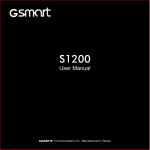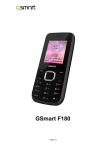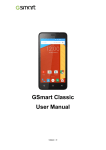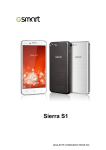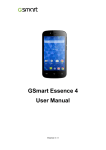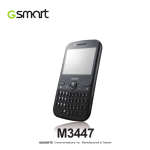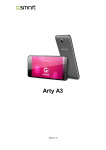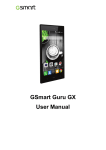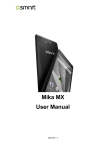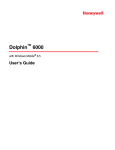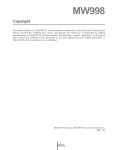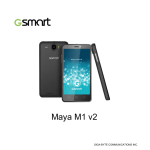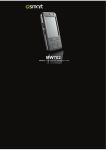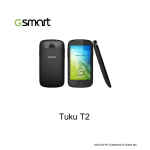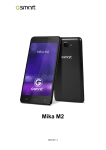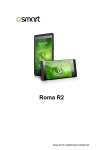Download Untitled
Transcript
Regulatory Agency Identifications For regulatory identification purposes, your product is assigned a model number of S1205. To ensure continued reliable and safe operation of your device, use only the accessories listed below with your device. Note: This product is intended for use with a certified Class 2 or Class 3 Limited Power Source, rated 5 Volts DC, maximum 1 Amp power supply unit. European Union Notice Products with CE marking comply with the R&TTE Directive (99/5/EC), the EMC Directive (89/336/EEC), and the Low Voltage Directive (73/23/EEC) & (2006/95/EC) issued by the Commission of the European Community. Compliance with these directives implies conformity to the following European Norms (in parentheses are the equivalent international standards) • EN 60950-1 (IEC 60950-1) Safety of Information Technology Equipment. • ETSI EN 301 511 Global system for mobile communications (GSM); Harmonized EN for mobile stations in the GSM 900 and GSM 1800 bands, covering essential requirements of article 3.2 of the R&TTE directive (1995/5/EC). • ETSI EN 301 489-1 Electromagnetic compatibility and Radio spectrum Matters (ERM); ElectroMagnetic Compatibility (EMC) standard for radio equipment and services; Part 1: Common technical requirements. • ETSI EN 301 489-7 Electromagnetic compatibility and Radio spectrum Matters (ERM); ElectroMagnetic Compatibility (EMC) standard for radio equipment and services; Part 7: Specific conditions for mobile and portable radio and ancillary equipment of digital cellular radio telecommunications systems (GSM and DCS). • ETSI EN 301 489-17 Electromagnetic compatibility and Radio spectrum Matters (ERM); ElectroMagnetic Compatibility (EMC) standard for radio equipment and services; Part 17: Specific conditions for 2.4 GHz wideband transmission systems and 5 GHz high performance RLAN equipment. S1205│ 0-3 Safety Information This chapter contains important information on safe and efficient operation. Please read this information before using the device. Exposure to Radio Frequency (RF) Energy The device contains a transmitter and a receiver. When it is ON, it receives and transmits RF energy. Please use the device appropriately. Specific Absorption Rate Data The Max SAR value for this device when tested for use at the ear NCC Max. SAR measurement GSM 900 MHz: 0.606 W/kg。 DCS 1800 MHz: 0.339 W/kg。 Road Safety Check the laws and regulations on the use of phones in the area where you drive. Do NOT use this device unless you use hands-free operation while driving or riding. Potentially Explosive Atmospheres Turn off your phone prior to entering any area with a potentially explosive atmosphere such as gas stations, explosive chemicals, or flammable objects. Aircraft Safety While in flight, turn off the functions of Wi-Fi, Bluetooth, Phone, and GPRS. When instructed to do so, turn off your phone when on board an aircraft. Facilities Turn off the device in any facility where posted notices instruct you to do so. These facilities may include hospitals or health care facilities that may be using equipment that is sensitive to external RF energy. Approved Accessories and Batteries Use only original or manufacturer approved accessories, batteries and chargers. S1205│ 0-2 Copyright All mobile products by GIGA-BYTE COMMUNICATIONS INC. mentioned in this document, including the device, accessories, software, text, music, and pictures, are owned by, or authorized by original manufacturers to GIGA-BYTE COMMUNICATIONS INC. Reproduction, transfer, distribution, or storage of part or all of the contents in this document in any form without the prior written permission of GIGA-BYTE COMMUNICATIONS INC. is prohibited. GIGA-BYTE Group, GIGA-BYTE COMMUNICATIONS INC. S1205│0-1 • ETSI EN 300 328 Electromagnetic compatibility and Radio spectrum Matters (ERM); Wideband Transmission systems; data transmission equipment operating in the 2.4 GHz ISM band and using spread spectrum modulation techniques. Safety precautions for RF exposure • Use only original manufacturer-approved accessories, or accessories that do not contain any metal. • Use of non-original manufacturer-approved accessories may violate your local RF exposure guidelines and should be avoided. Exposure to Radio Frequency (RF) Signals Your device contains a radio transmitter and receiver. The radiated output power is far below the international radio frequency exposure limits. These limits are part of comprehensive guidelines and establish permitted levels of RF energy for the general population. The guidelines are based on the safety standards previously set by international standards bodies: • American National Standards Institute (ANSI) IEEE. C95.1-1992 • National Council on Radiation Protection and Measurement (NCRP). Report 86. 1986 • International Commission on Non-Ionizing Radiation Protection (ICNIRP) 1996 • Ministry of Health (Canada), Safety Code 6. The standards include a substantial safety margin designed to assure the safety of all persons, regardless of age and health. The exposure standard for wireless mobile phones employs a unit of measurement known as the Specific Absorption Rate, or SAR. The standard incorporates a substantial margin of safety to give additional protection for the public and to account for any variations in usage. As with other mobile radio transmitting equipment, users are advised that for satisfactory operation of the equipment and for the safety of personnel, it is recommended that no part of the human body be allowed to come too close to the antenna during operation of the equipment. Your device has an internal antenna. Use only the supplied integral antenna. Use of unauthorized or modified antennas may impair call quality and damage the phone, causing loss of performance and SAR levels exceeding the recommended limits as well as result in non-compliance with local regulatory requirements in your country. To assure optimal phone performance and ensure human exposure to RF energy is within the guidelines set forth in the relevant standards; always use your device only in its normal-use position. Do not touch or hold the antenna area unnecessarily when placing or receiving a phone call. Contact with the antenna area may impair call quality and cause your device to operate at a higher power level than needed. Avoiding contact with the S1205│ 0-4 antenna area when the phone is IN USE optimizes the antenna performance and the battery life. Telecommunications & Internet Association (TIA) safety information Pacemakers The Health Industry Manufacturers Association recommends that a minimum separation of six inches be maintained between a handheld wireless phone and a pacemaker to avoid potential interference with the pacemaker. These recommendations are consistent with the independent research by and recommendations of Wireless Technology Research. Persons with pacemakers: • Should ALWAYS keep the phone more than six inches from their pacemaker when the phone is turned ON. • Should not carry the phone in a breast pocket. • Should use the ear opposite the pacemaker to minimize the potential for interference. If you have any reason to suspect that interference is taking place, turn the phone OFF immediately Hearing Aids Some digital wireless phones may interfere with some hearing aids. In the event of such interference, you may want to consult your service provider, or call the customer service line to discuss alternatives. Other Medical Devices If you use any other personal medical device, consult the manufacturer of your device to determine if they are adequately shielded from external RF energy. Your physician may be able to assist you in obtaining this information. Turn the phone OFF in health care facilities when any regulations posted in these areas instruct you to do so. Hospitals or health care facilities may be using equipment that could be sensitive to external RF energy. WEEE Notice The Directive on Waste Electrical and Electronic Equipment (WEEE), which entered into force as European law on 13th February 2003, resulted in a major change in the treatment of electrical equipment at end-of-life. The purpose of this Directive is, as a first priority, the prevention of WEEE, and in addition, to promote the reuse, recycling and other forms of recovery of such wastes so as to reduce disposal. The WEEE logo (shown at the left) on the product or on its box indicates that this product must not be disposed of or dumped with your other household waste. You are liable to dispose of all your electronic or electrical waste equipment by relocating over to the specified collection point for recycling of such hazardous waste. Isolated collection and proper recovery of your electronic and electrical waste equipment at the time of disposal will allow us to help conserving natural resources. Moreover, proper recycling of the electronic and electrical waste equipment will ensure safety of human health and environment. For more information about electronic and electrical waste equipment disposal, recovery, and collection points, please contact your local city center, S1205│ 0-5 household waste disposal service, shop from where you purchased the equipment, or manufacturer of the equipment. RoHS Compliance This product is in compliance with Directive 2002/95/EC of the European Parliament and of the Council of 27 January 2003, on the restriction of the use of certain hazardous substances in electrical and electronic equipment (RoHS) and its amendments. S1205│ 0-6 General Information This chapter contains important information on safe and efficient operation. Please read this information before using the device. Ignorance of the following notices may lead to violations of the law. • • • • • • • • • • • • • • • Before using the device, please make sure you have fully charged the battery. Do NOT remove the battery from the device during charging. Before inserting SIM card into the device, make sure that the device is switched off. Do NOT attempt to dissemble the device on your own. This should be done by an authorized person. Use the device in accordance to instructions when in public facilities. In some countries, it is a violation against the law to record phone conversations. Always ask permission of the other party when you are going to record a conversation. To protect your ears, turn down the volume before you use stereo headsets or other audio devices. To avoid damaging the touch screen and the device, do NOT apply excessive pressure on them, and remove the device from your pants’ pocket before you sit down. It is also recommended that you only use the stylus or your finger to interact with the touch screen. It is not covered by the warranty that you crack the touch screen because of the improper usage. When you use the device for a long time, such as talking on the phone, browsing online, or charging the battery, the device may become warm. In most cases, this condition is normal. Refer servicing to the provider, or an authorized technician under the following conditions: 1. The device has been damaged. 2. When you follow the instructions to use your device, it does not operate normally. 3. The device has been exposed to water. 4. Liquid has been spilled or an object has fallen onto the device. Do Not push unauthorized objects into slots and openings in your device. The device should be placed away from heat sources such as stoves, radiators, heat registers, or other products that produce heat. Condensation may form on or within your device, when you move your device between environments with very different temperature and/or humidity ranges. To avoid damaging your device, make the moisture to evaporate before you use the device. To avoid damaging your device, do Not put your device on an unstable table, stand, bracket, or other places. Before you clean your device, unplug it, please. Use a damp cloth for cleaning, but do Not use water, liquid cleaners, or aerosol cleaners to clean the touch screen. S1205│ 0-7 Table of Contents Copyright .................................................................................................................................................... 0-1 Safety Information ...................................................................................................................................... 0-2 Regulatory Agency Identifications .............................................................................................................. 0-3 General Information .................................................................................................................................... 0-7 Chapter 1 Getting Started ........................................................................................................................ 1-1 1.1 Device Information................................................................................................................................ 1-1 1.2 Battery .................................................................................................................................................. 1-3 1.3 SIM Card .............................................................................................................................................. 1-3 1.4 Lock/Unlock .......................................................................................................................................... 1-4 1.5 Screen Orientation................................................................................................................................ 1-4 1.6 Display Information ............................................................................................................................... 1-5 Chapter 2 Phone Functions ..................................................................................................................... 2-1 2.1 Use Your Phone ................................................................................................................................... 2-1 2.2 Receive/Ignore a Call ........................................................................................................................... 2-1 2.3 Call History ........................................................................................................................................... 2-1 2.4 Other Information.................................................................................................................................. 2-3 Chapter 3 Input ......................................................................................................................................... 3-1 3.1 Input Method ........................................................................................................................................ 3-1 3.2 Draw on the Screen .............................................................................................................................. 3-2 3.3 Record a Message ............................................................................................................................... 3-3 Chapter 4 Settings .................................................................................................................................... 4-1 4.1 Personal ............................................................................................................................................... 4-1 4.2 System ................................................................................................................................................. 4-2 Chapter 5 Synchronization ...................................................................................................................... 5-1 5.1 About ActiveSync ................................................................................................................................. 5-1 5.2 Install and Use ActiveSync ................................................................................................................... 5-1 5.3 Synchronize via Bluetooth .................................................................................................................... 5-2 Chapter 6 Getting Connected .................................................................................................................. 6-1 6.1 Internet Access ..................................................................................................................................... 6-1 6.2 GPRS Connection Settings .................................................................................................................. 6-1 6.3 Bluetooth Wireless Transmissions........................................................................................................ 6-2 6.4 Internet Sharing .................................................................................................................................... 6-2 6.5 Wi-Fi ..................................................................................................................................................... 6-3 6.6 USB To PC ........................................................................................................................................... 6-3 6.7 Domain Enroll ....................................................................................................................................... 6-3 S1205│ 0-8 6.8 Beam .................................................................................................................................................... 6-4 Chapter 7 Messaging ............................................................................................................................... 7-1 7.1 SMS\MMS ............................................................................................................................................ 7-1 7.2 Establish an E-mail Account ................................................................................................................. 7-2 7.3 Use E-mail ............................................................................................................................................ 7-2 7.4 Synchronously Process E-mail ............................................................................................................. 7-2 7.5 Use Push E-mail ................................................................................................................................... 7-3 7.6 Messenger............................................................................................................................................ 7-4 Chapter 8 Multimedia ............................................................................................................................... 8-1 8.1 Camera................................................................................................................................................. 8-1 8.2 Video Mode .......................................................................................................................................... 8-2 8.3 Pictures & Videos ................................................................................................................................. 8-2 8.4 JAVA .................................................................................................................................................... 8-3 8.5 FM Radio .............................................................................................................................................. 8-3 8.6 Photo Album ......................................................................................................................................... 8-3 Chapter 9 Applications ............................................................................................................................ 9-1 9.1 Calendar ............................................................................................................................................... 9-1 9.2 Contacts ............................................................................................................................................... 9-1 9.3 Tasks .................................................................................................................................................... 9-2 9.4 Microsoft Office Mobile ......................................................................................................................... 9-2 9.5 Windows Media Player ......................................................................................................................... 9-3 9.6 Internet Explore .................................................................................................................................... 9-4 9.7 Calculator ............................................................................................................................................. 9-5 9.8 Games .................................................................................................................................................. 9-5 9.9 Stopwatch ............................................................................................................................................. 9-5 9.10 Zip ...................................................................................................................................................... 9-5 9.11 Pocket Backup.................................................................................................................................... 9-5 9.12 Search Phone ..................................................................................................................................... 9-6 9.13 Remote Desktop Mobile ..................................................................................................................... 9-6 9.14 Voice Commander .............................................................................................................................. 9-6 Chapter 10 Specifications........................................................................................................................ 10-1 Chapter 11 FAQ ........................................................................................................................................ 11-1 S1205│ 0-9 1. Getting Started 1.1 Device Information This section introduces you to the hardware of the device. 4 Call Key Press this key to make or answer a call. 5 End Key Press this key to end a call or to return to Today screen from any screen. 6 Confirm Key 7 8 9 No. 1 Touch Screen Items 2 Windows Flag Key Functions Display screen. Use stylus to select items on screen. Press to open Start menu options. 3 Phone Settings Key Press to launch phone settings screen Select an icon on screen, and then, press this key to activate the function of that icon. The LED indicator indicates the status of your device by showing different colors. Red: Charging is LED Indicator activated. Green: Mobile network is detected. Blue: Bluetooth, Wi-Fi, GPS is activated. The source of music and Receiver/Speaker voice. Hold down this key for a Power Key few seconds to turn on/off your device. 10 Micro USB slot Use USB connector to synchronize data with your desktop PC, and transmit data or charge the battery. It is also a handset plug. 11 Headset Plug You can listen to music via headset. S1205│ 1-1 hold down on a desired item until the pop-up menu appears. 12 Volume Key 13 Micro SD card slot 14 Camera Key Press the key to increase or decrease the earpiece volume during a call or when playing music. You can insert your Micro SD card here. Press this key to launch camera. 15 Camera Lens The Camera on the back of the device supports 3-mega-pixel photo and high-quality video. 16 Stylus There are 2 ways to use your stylus: ․Tap:Tap a desired item by your stylus, and then, lift the stylus from the screen. ․Press:Use your stylus to No. Items Functions Remove the battery cover, and then, install the battery and insert your SIM card into the carrier. 17 Battery Cover Remove the battery cover and the stylus. Then you can find the reset button. Press it to reset your phone. 1.2 Battery Your device comes with a removable and rechargeable Lithium Polymer battery. The standby time and talk time will vary depending on the local network and individual usage. S1205│ 1-2 Note: Using any battery pack or AC adapter (charger) not specified/endorsed by GSmart on this phone may be dangerous and may invalidate any warranty and approval given to the device. Unplug the charger from the power supply when it is not in use. Open Battery Cover Push the battery cover upwards, and then, remove it. Charging the Battery Please make sure that the battery is installed and fully charged when use your device for the first time. You may charge the battery in the following ways: 1. Universal AC Adapter: Plug your AC adapter into a suitable main power socket, and plug the connector to the charging slot of your device. The phone will start charging automatically. 2. USB Cable: Connect your device and your PC with the USB cable supplied in your package. Power On/Off Press Power On/Off key on the top of the device to turn on/off the device. To reduce the power consumption of your device, you may change the backlight duration and brightness level. period of time, the device enters Sleep Mode automatically. You may also manually enter Sleep mode by pressing Power Key. The backlight of the screen will turn off and the device will activate Sleep Mode. When your device is in Sleep Mode, it will not respond to any operation or touches on screen and on the keypad. 2. Press Power Key again to exit Sleep mode. 3. You may adjust time to activate Sleep Mode. The device will enter Sleep Mode automatically, when no operation is done within a period of time. ․Tap Start > Settings > Power > Advanced tab. ․Select your desired time period on “On battery power” or “On external power”. ․Tap OK to complete this setting. 1.3 SIM Card Before inserting/removing a SIM card, please make sure that the device is turned off and is not connected to any power supply. 1. Push the battery cover upwards, and then remove it. 2. Find the SIM card slot on the upper section of the device. 3. Insert the SIM card into the slot. The metal contacts on the SIM please face down. There are two slots for two SIM cards. Upper slot is for SIM1, SIM2 slot is on the underside. Tap Start > Settings > Power > Advanced tab, and then, select the duration of the backlight. This function helps you save power. Battery Power Tap Start > Settings > Power > Battery tab. The bar indicates the remaining power of the battery. Sleep Mode 1. Sleep Mode is a power saving mode designed to reserve the power of the battery. After idling for a 4. Please always remember to pull down the SIM card latch for locking your SIM card safely. If you don’t pull down the SIM card latch, the device S1205│ 1-3 won’t power on and battery cover can’t be pulled back. The SIM card latch is on the upper-right corner of the device. 5. Return the battery back to the battery slot, and then, return the battery cover back onto the device. 6. Push the battery cover back, and then, you will hear “click”. 1.4 Lock/Unlock 1. Lock the device: Tap Start > Lock to lock the device. The device will not respond to touches on screen nor react to any input on the keypad, when it is locked. 2. Unlock the device: Slide Lock icon on the screen, and then, the device will be unlocked. Note: The Lock/Unlock procedure is based on the lock display of Windows Default. Advanced Lock Settings You can create a personal password to lock your device. A strong password must have at least 7 characters that are a combination of uppercase and lower case letters, numerals, and punctuations. 1. Tap Start > Settings > Lock 2. To enable this function, select how long your device must be turned off before the password is required for using the device. Tap “Prompt if phone unused for”. 3. Select the type of password you would like to use: Strong alphanumeric or Simple PIN. 4. Enter the password, and type it again in Confirm field. 5. On Hint tab, the system provides a hint for the password in case you forget your password. This hint may be visible by others. 6. On Display tab, you can change the unlock display. 7. Tap OK to save the settings. ․If your device is configured to connect to network, use a strong password to help protect network security. ․If you forget your password, you must reset the device. The reset function will erase all files, data, and programs. ․If you have used ActiveSync to create a backup file, all of your program data can be restored. 1.5 Screen Orientation You can change the display of the screen. The Portrait mode allows you to get a better view or a better operation of certain programs on your device, while Landscape may be optimal for viewing longer text files. Tap Start > Settings > System > Screen > General tab. 1. On General tab, select your desired orientation: Portrait, Landscape (right-handed), or Landscape (left-handed). 2. Tap OK, and the screen will be changed accordingly. S1205│ 1-4 certain programs and important information of today. Tap Start > Settings > Today, you can change the settings of Today screen. 4. Command Area Depending on different mode, this area contains different features such as menu options, Input Method and commands to create or edit a file. 5. Pop-up Window It allows you to access an item quickly. Tap the selected item to perform an action. To cancel this pop-up window, tap other areas of this screen. Portrait Landscape 1.6 Display Information The main screen displays the following information: 1. Start Menu Tap “Start” to open Start Menu. Tap Start > Today, you can return to Today screen at any time. 2. Status & Icon Area Display icons of notifications and the status of the system. You can tap the icons to get the details of the functions. 3. Today Screen On Today screen, this area contains shortcuts to S1205│ 1-5 E-mail Contacts Internet Explorer Getting Started Marketplace Messenger Start Menu Icons Microsoft My Phone Programs Today Descriptions Switch to Today Screen. Settings Help you adjust your device. Games Camera, Pictures & Videos, FM Radio, Photo Album, Windows Media Calculator, Zip, Stopwatch, Calendar, RingtoneSettings, Notes, ActiveSync, Pocket Backup, Adoebe Reader LE Tasks Multimedia Tools Phone Text Windows Live Office Mobile File Explorer Search Phone Phone functions. SMS\MMS. Help S1205│ 1-6 SMS\MMS, Setup E-mail. Your contacts in your device. Help you Browse online. A quick guide for some functions you may use frequently. Help you get more applications. Perform MSN. My Phone service synchronize your data in your device with you’re my Phone account. A search engine of Microsoft. Bubble Breaker, Solitaire. Help you track unfinished tasks. Word Mobile, Excel Mobile, PowerPoint Mobile, and OneNote Mobile. Manage the files in your device and storage card (if you have). Search for all data, programs, and files. Help you use the applications. Connect, and control your desktop computer from your device. Remote Desktop Mobile Search Widget Live Search. Voice Commander Spb Keyboard Start programs and functions with voice. Spb input method and some options Settings Tap Start > Settings Programs Descriptions Bluetooth Settings for Bluetooth functions. Clock & Alarms Settings for time and alarms. You can create a personal password for the device. Help you examine power status Power and wireless signals. Sounds& Settings for sounds, notifications, Notifications and vibrations. Settings for the items which are Today displayed on Today screen. Lock Connections More Connections Settings. Personal More Personal Settings. System More System Settings. Tap Start > Settings > Connections Programs Descriptions You can choose to receive all Beam incoming beams. Settings and management for Connections modem connections. Enrolling in a domain will Domain Enroll connect your device with company resources. Set data connection auto ConnectConfig configure or not. Using SIM1 or SIM2 for current NetworkRouter connection. Select ActiveSync or Disk Drive USB to PC for connection type. Wi-Fi Configurations for Wi-Fi. Turn on/off Wi-Fi, Bluetooth, Wireless Phone, GPRS, Push E-mail, and Manager Flight Mode. Tap Start > Settings > Personal Programs Descriptions Owner Information You may assign programs to hard keys. You can adjust your preferred input method. You may input your personal information. Phone Settings for functions of your phone. Buttons Input Tap Start > Settings > System Programs Descriptions About Contain information of the device. Backlight Settings for the backlight. Clean all the personal information, and CleanBoot restore to default. Customer Customer Experience Improvement S1205│ 1-7 Feedback Device Information Encryption Error Reporting External GPS Program. You can check the information of your device. Encrypt data in your Micro SD card. Report the errors which exist in the system operation. Managed Programs Help you examine the installed programs. Status & Icon Area This area shows status and alerts of the system. You can tap the icons to get the details and the settings. Status Icons Descriptions Types The power of the battery is full. GPS settings Battery Help you examine memory status and running. programs. You can activate Quick Menu Setting Quick Menu to help you adjust the frequently used Setting settings. Regional Settings for region, number, currency, Settings time, and date. Remove Remove programs from your device. Programs The power of the battery is low. Please recharge. Memory Schedule On/Off Screen Task Manager Battery is charging. Call forward. Call on hold. Calls Set when the power will on or off You have missed calls. Help you adjust screen orientation, screen alignment, and text size. Help you examine the applications which are using. You can examine their amount of memory and their CPU consumption. Voice Settings about activating programs Commander and functions with voice. Settings Data call. Voice call is active. No connections GPRS is in range. Connection GPRS is connected. Building connection to GPRS. Bluetooth is activated. S1205│ 1-8 You have one or more new voice mail(s). Wi-Fi is activated; a Wi-Fi network is in range; Wi-Fi network is connected. You have one or more instant message(s). SIM1 has strong signal. SIM2 has strong signal. System volume. Ring volume Volume Ringer is on. SIM1 no service. Ringer is off. SIM2 no service. SIM1 has no SIM card. Signal Quick Menu Setting SIM2 has no SIM card. SIM1 phone off. SIM2 phone off. Roaming. Trying to connect GPS; GPS is connected. Message You have one or more new message(s). S1205│ 1-9 Help you adjust the frequently used settings. 2. Phone Functions tapping the letters of alphabet located at the left side of the screen helps you find your contacts quickly. 2.1 Use Your Phone Press Call Key to enter Phone function screen. Please insert a SIM card before using these functions. Tap to hide Search Menu, and to show it. 1. Slide the bar upwards or downwards to browse contacts by initial letters in Contacts. 2. You can select a contact to make a call to him or her. 3. Tap “Menu” for more options. Phone Dial Screen 1. The number you entered 2. Clear numbers 3. Keypad 4. Call History 5. Make a phone call by SIM1 6. Make a phone call by SIM2 7. Hide Keypad 8. Menu Create a New Contact On Contacts screen, tap “New” first. Then, you can select “Outlook Contact” or “SIM Contact”. After you select one of them, you can edit the contact’s information. 1. You can create a photo for an incoming call, and it will be displayed as a Photo ID. 2. You may also tap Ring tone field to adjust the ring tones for your contacts. 3. Tap OK to save the new contact, and then, exit the screen. 2.2 Receive/Ignore a Call When you receive a phone call, a message of notification will appear. To answer the incoming call, tap “Answer” or “Talk”. To ignore or reject a call, tap “Ignore” or “End”. This behavior may divert the call to your voice mail depending on your network operator. 2.3 Call History Make a Call from Contacts On Today screen, you can tap Contacts which is on the down left of the screen to enter Contacts. Enter a contact name or phone number you intend to search in the search field, the phone will search for the contact that matches this condition. Besides, Call History contains all outgoing calls, incoming calls, and missed calls. You may choose to display all or only display the highlighted items. 1. On Today screen, tap Call Key. 2. Then tap Menu to select “Call History”. 3. Tap Menu to select a desired function to perform. S1205│2-1 You may change the display method of Call History by selecting “Filter”; You can also select “Call Timers” to check numbers of incoming calls and calling time. 4. On Call History screen, select a contact to redial the number. 5. On Call History screen, hold down on a phone number to open a menu for more options. 2.4 Other Information Phone Settings Setting for Phone functions. You can easily view, and change settings, such as Ring type, Ring tone, and Keypad. You can also protect your device from the unauthorized use. If you select Long tones, the tones of the keys will be continuous, when you input a phone number. If you select Short tones, the tones of the keys will be only continued one or two seconds, when you input a phone number. If you select Off, the tones of the keys will be cancelled, when you input a phone number. Security tab You can check “Require PIN when phone is used” to enhance the security of your phone. Tap “Change PIN” or “Change PIN2” to change the PIN number of your SIM. Services tab Settings include Call Barring, Caller ID, Call Forwarding, Call Waiting, Voice Mail and Text Messages, and Fixed Dialing. ․Tap Start > Settings > Personal > Phone. Phone tab On Phone tab, you can adjust the following items: Ring type You can change the way that you are notified when a call is incoming. For example, you can choose to be notified by a ring, a vibration, or a combination of both. Tap the list of Ring type, and select an item. Ring tone Display the list of Ring tone, and then, select an item. 1. To use .wav or .midi files as ring tones, use ActiveSync on your PC to copy the files to the Rings folder on your device. Then, select an item in the list of Ring tone. 2. To download ring tones, you can make a connection to the Internet, and then, download ring tones that are compatible with the formats of .wav or .midi. 1. Tap Start > Settings > Personal > Phone > Services tab. 2. Select an item, and then, tap Get Settings. 3. Tap OK to save settings. Options Descriptions Call Barring Block incoming and/or outgoing calls. Display your name and/or phone Caller ID number for outgoing calls. Call Forward all or selected incoming calls Forwarding to a different phone number. Notify you an incoming call while you Call Waiting are on the line. Voice Mail Settings about voice mail and SMS and Text service center. Messages Fixed You can only dial some phone number. Dialing Keypad You can use this function to change the tones of the keys. S1205│2-2 Note: All services in Services tab are provided by operators. Please contact your operator for more information. Network tab Tap Start > Settings > Personal > Phone > Network tab. ․Under Current network, tap "Find Network” to search for the network automatically. ․Under Network selection, select “Automatic” or “Manual” for searching a network automatically or manually. ․Under Preferred networks, tap “Set Networks” to adjust the preferred order of networks. Make an International Call When you make an international call, you need to insert an international access code before the dialed phone number. If you enter “+” as prefix, you do not need to enter the international access code. The "+" can be reached by holding down the "0" key until it turns into a "+". 1. Enter the full phone number you want to dial. It should include the country code, area code (without the leading zero), and phone number. 2. Tap Talk, or press Call Key. Make an Emergency Call Enter the international emergency number 112, and then, tap “Talk” or press Call Key. Additional emergency numbers may be included in your SIM card. Contact your network operator for more information. If your device has entered Device Lock Mode, you have to unlock the device before you make an emergency call. S1205│2-3 3. Input 3.1 Input Method 1. Start a program such as Word Mobile and Notes. 2. Input Method at the lower center of the screen. Tap the arrow beside Input Method to select an input method. Letter Recognizer. 2. Write letters and numbers in a corresponding field. Spb Keyboard Spb Keyboard is a unique onscreen keyboard for quick and accurate finger typing. A visible feedback of the key currently pressed make finger typing very convenient and as easy as sliding a finger over the screen. Half and full screen modes are available to satisfy your typing needs. Half-Screen Mode Spb Keyboard works in half-screen mode so you can use it as the standard input method that integrates very well with Windows Mobile. This keyboard has been also designed for finger-tip typing for faster input and less effort. Block Recognizer 1. Tap the arrow beside Input Method to select Block Recognizer. 2. Write letters and numbers in a corresponding field, the system will display the letters/numbers identified from your handwriting. 3. Do not write letters outside of the input fields. Keyboard 1. Tap the arrow beside input Method to select Keyboard. 2. Tap “CAP” or “Shift” to input capital letters. Letter Recognizer 1. Tap the arrow beside Input Method to select 1. Characters zone. 2. Shift key (for case switching). Tap twice to keep it active. 3. Symbols switching key. 4. Keyboard key. Switch to the full-screen mode. Tap and hold to switch to the standard keyboard mode. 5. The Control key is used to perform a special operation when tapped in conjunction with another key (for example, Control-C -> Copy). This key can be used to change the keyboard language layout S1205│ 3-1 when a second language is added. 6. Enter key. 7. Backspace key. Full-Screen Mode Spb keyboard works in full screen mode (landscape) so you can use the entire device screen area to type text. The full screen mode allows you to type with your finger tips. Full Screen mode is a standard QWERTY keyboard that was specially designed for thump-tip typing. combination of both. Transcriber works transparently in the background of programs, recognizing words with its integrated dictionary. When Transcriber is turned on, it interprets stylus movement anywhere on the screen as handwriting input. 1. Tap the arrow beside Input Method to select Transcriber. 2. Position the cursor where you want texts to appear. 3. Use the stylus to write anywhere on the screen. The handwriting will be converted to texts after you lift the stylus from the screen. 3.2 Draw on the Screen You can draw on the screen in the same way that you write on the screen. The difference between writing and drawing on the screen is how you select items and how they can be edited. For example, the selected drawings can be resized, while writing cannot. Tap Start > Tools > Notes. Then, tap “New” to create a new note. 1. Characters zone. 2. Shift key (for case switching). Tap twice to keep it active. 3. Symbols switching key. 4. Keyboard key. To switch to the half-screen mode. 5. To change the keyboard language layout. 6. Move left key. 7. Move right key. 8. Enter key. 9. Backspace key. 10. The text zone. 11. Tap to open Spb Keyboard menu and view the available options. Create a Drawing Cross three ruled lines on your first stroke. A drawing box appears. Subsequent strokes in the drawing box will become parts of the drawing. Drawings that do not cross three ruled lines will be treated as writing. Transcriber Transcriber is a program of handwriting recognition that allows you to write in cursive, print, or a S1205│ 3-2 4. To start recording, tap . 5. To stop recording, tap the note. . Select a Drawing To edit a drawing, select it first. 1. Use the stylus to hold down on a drawing until a “+” appears. Drag this “+” to select the drawing you want, and then, lift the stylus. 2. You can cut, copy, and paste the selected drawings by selecting those items in Menu. 6. To play a recording, tap 3.3 Record a Message Menu > View Recording Toolbar. Tap Create a Recording 1. To add a recording to a note, open a note before recording. Tap Start > Notes. Then, tap “New” to create a new note. 2. If there is no Recording Toolbar, tap Menu > View Recording Toolbar. 3. Move your device’s microphone near your mouth or other sources of sounds. will be added in in a note, or tap in the list of Notes. The recording can be saved in the list of Notes. Tap tap S1205│ 3-3 . , and then, 4. Settings Clock & Alarms Adjust time and alarms. Tap Start > Settings > Clock & Alarms. 1. On Time tab, adjust Time Zone, Date, and Time. 2. Tap OK, and then, the pop-up window will ask whether you will save the changes. 3. Tap “Yes” to save the changes and exit. ․On Alarms tab, you can adjust the settings of alarms. ․On More tab, you can adjust more settings. ․Tap Start > Settings > System > Regional Settings to change the format of the time or the date. “Browse” to locate the desired file. 3. Choose a folder, and then, tap the file you want. 4. Tap OK to save it. Note: The recommended picture size for the background is 240 x 400 pixels in jpeg file format. To beam a favorite theme to a friend, select the desired theme, and then, tap “Beam” on Appearance tab. To customize the displayed information: 1. Tap Start > Settings > Today > Items tab. 2. Select the items you want. Then they will be displayed on Today screen. 3. To customize further, select an item, and then, tap “Options” (not available for all items). Sounds & Notifications Adjust sounds of alarms, notifications, and vibrations. Turning off sounds and notifications helps conserve the power of the battery. 1. Tap Start > Settings > Sounds & Notifications. 2. On Sounds tab, you can check the items you want. 3. On Notifications tab, you can customize how you are notified. Select an event, and then, select the type of the reminder. 4. On Vibrations tab, you can enable vibrations. Today Change screen appearance and items displayed on Today screen. To change the theme of Today screen: 1. Tap Start > Settings > Today. 2. On Appearance tab, select the desired theme. To use your own background, check “Use this picture as the background”, and then, tap Microsoft My Phone My Phone service synchronize your phone’s contacts, calendar, tasks, text messages, music, photos, videos, and other documents with your My Phone account at http://myphone.microsoft.com. 1. Tap Start > Microsoft My Phone. 2. Sign with your Windows Live ID and password. Then tap “Sign in.” 3. Select a synchronization method. Then, tap Next. 4. Select the data types to sync. 5. Follow the instructions, and then, tap Finish. 6. Tap Sync to begin the synchronization. 4.1 Personal Buttons You may assign programs to a hardware button. Tap Start > Settings > Personal > Buttons. S1205│ 4-1 Owner Information You can input your personal information in Owner Information to help you identify your phone. 1. Tap Start > Settings > Personal > Owner Information. 2. On Identification tab, enter your personal information. issuer and the expiration date. Tap Start > Settings > System > Certificates. Input You can set input settings here. Tap Start > Settings > Personal > Input. ․On Input Method tab, you can choose input method options. ․On Word Completion tab, you can check the boxes if you want suggest words or enable auto correct. ․On Options tab, you can choose voice recording format, and check the boxes if you would like capitalize first letter of sentence or scroll upon reaching the last line. Customer Feedback It is Customer Experience Improvement Program designed by Microsoft®. You can check “Send Feedback” to participate or “Don't Send Feedback” to reject. Tap Start > Settings > System > Customer Feedback. CleanBoot This application will clean all your personal information, and restore the default settings. Tap Start > Settings > System > CleanBoot. 4.2 System About This function contains the information of your device. Tap Start > Settings > System > About. Backlight Adjust the settings of the backlight, and adjust the level of the brightness to save power. Tap Start > Settings > System > Backlight. ․On Battery Power tab, you can turn ON/OFF the backlight, when you use the power of the battery. ․On External Power tab, you can turn ON/OFF the backlight, when you use the external power. ․On Extended tab, you can adjust the level of the brightness. ․Tap “Power” to adjust the settings of the power. Certificates Tap Certificates to view the name of the certificate Device Information Check the information of your phone. Tap Start > Settings > System > Device Information. Encryption You can encrypt files stored on the Micro SD card by simply checking “Encrypt files when placed on a storage card”. Once encrypted, such files are only readable by this device. Tap Start > Settings > System > Encryption. Error Reporting To help Microsoft improve the products you use, your device can collect information on software operation for later reporting in the event of a serious error. Reporting the information is completely voluntary and confidential. Tap Start > Settings > System > Error Reporting. External GPS This is GPS setting application. ․On Programs tab, you can choose the port that programs will use to obtain GPS data. ․On Hardware tab, specify the hardware port to which your GPS device is connected. ․On Access tab, Windows Mobile manages access S1205│ 4-2 to your GPS device and allows multiple programs to obtain GPS data simultaneously. Managed Programs Examine the installed programs. Tap Start > Settings > System > Managed Programs. Memory Display memories of programs that are currently running. You may need to stop a program, if it becomes unstable. Tap Start > Settings > System > Memory. ․Main tab displays the amount of the memory. This tab shows storage’s and program’s memories. You can examine the total, in-use, and free memories. ․Storage Card tab displays how much memory is available on the storage card. Quick Menu Setting Help you adjust the frequently used settings. Tap Start > Settings > System > Quick Menu Setting. Screen Adjust screen’s orientation, screen alignment, and text size. Tap Start > Settings > System > Screen. Task Manager Examine the applications that you are using. You can examine the amount of the memory and the consumption of CPU. Tap Start > Settings > System > Task Manager. Voice Commander Settings ․Voice Commander: You can go to “Voice Commander” in Start to start what you record. ․Voice Commander Settings: You may record voice tags under “Voice Commander Settings”, or train you the way of digit speaking under digit training. Tap Start > Settings > System > Voice Commander Settings. Regional Settings This function allows you to customize the unit and format for the region you are in. Tap Start > Settings > System > Regional Settings. Adjust the formats of region, number, currency, time, and date. Remove Programs This function allows you to uninstall programs that are saved in your device’s storage memory. It also shows the total available storage memory. Select a program that you would like to remove from the program box, and then, tap “Remove”. Tap Start > Settings > System > Remove Programs. Schedule Power On/Off You can choose when you want the device power on or off. Tap Start > Settings > System > Schedule Power On/Off. ․On Contacts tab, select a contact in the list of contacts. ․Select a contact, and then, tap S1205│ 4-3 to create a voice tag. ․If the selected contact has different phone numbers, select one of them, please. ․After you tap voice. , the system will record your ․When the voice tag is built, showed beside the contact. will be to re-build a voice tag. ․You can tap Tap to delete a voice tag. ․On Application tab, you can record a voice tag of an application. ․On Music tab: If you have MP3 files in the device or in Micro SD card, you may record voice tags for those MP3 files. ․On Digit Training tab, you can practice your pronunciations. You can press to record the following digits in “Digit model adaptation”. You to delete the recorded can press pronunciations. ․On Digit Settings tab, you can adjust the length of phone number showed in Voice Commander. ․On Advanced Settings tab, you can change the recording sensitivity. ․On About tab, you can get the details of Voice Commander. S1205│ 4-4 5. Synchronization 5.1 About ActiveSync You may use Microsoft ActiveSync to synchronize data in this device with your personal computer. ․You can update Outlook data in this device and in your personal computer synchronously. ․You can synchronize Microsoft Word and Microsoft Excel files in this device and in your personal computer. The files will convert to the compatible version automatically. The default of ActiveSync is not to synchronize all data automatically. If you would like to change the default, you may activate or disable the function of the synchronization for specific data in ActiveSync Option. ActiveSync may also be used for the following purposes: ․Back up or restore the saved data in this device. ․Copy files between this device and personal computer. ․Synchronize while connecting to your personal computer or selecting synchronization command. ․Synchronize specific types and range of files. For example, you may choose to synchronize appointments of the past few weeks. ActiveSync on Windows XP 1. ActiveSync Installation: Install Microsoft ActiveSync in your personal computer. Please download the Microsoft ActiveSync from Microsoft web site www.microsoft.com/getstarted. 2. Hardware Connection: Connect your Windows Mobile-based device to your personal computer with a USB cable. 3. Use ActiveSync Program: The ActiveSync wizard will give you step-by-step instructions for synchronizing files and loading programs onto your device. Follow the instructions to complete the settings, please. ․After you connect this device to your personal computer with a USB cable, the screen of the computer will display “Connected” upon successful connection. A green icon representing “connected” will appear on the task bar of your computer screen. ․Select the Explore button of ActiveSync program to view the files in your device. You may manage several files in the device simultaneously. 5.2 Install and Use ActiveSync Note: Before installing ActiveSync, do not connect your device to the computer. You can connect your device to the computer with a USB cable after installing ActiveSync. S1205│5-1 ActiveSync on Windows Vista Microsoft Windows Mobile Device Center is the replacement for Microsoft ActiveSync on Windows Vista. Start by visiting Microsoft Web Site. A Windows Mobile partnership needs to be created, when you connect your phone to your PC and start Windows Mobile Device Center for the first time. The steps are below: 1. Connect your phone to your computer. Windows Mobile Device Center configures itself, and then, it will open. 2. Follow the instructions to complete the settings, please. 3. Select the items to synchronize, tap “Next”. 4. After you complete the settings, Microsoft Windows Mobile Device Center will synchronize your phone automatically. 5.3 Synchronize via Bluetooth You can synchronize data via Bluetooth. Tap Start > ActiveSync > Menu, and then, select “Connect via Bluetooth” and tap ”Sync” in this device to process synchronization. Note: If you want to synchronize your phone and your computer via Bluetooth, your computer needs to have a Bluetooth receiver, a host adapter, or a built-in Bluetooth. S1205│5-2 6. Getting Connected 6.1 Internet Access Before you use GPRS to connect to the Internet, please make sure your system operator provide this service. It is convenient to work at home or travel by using GPRS. You can use this device to browse online, read or send E-mail, and MSN messages through a wireless network. 6.2 GPRS Connection Settings GPRS Settings 1. Tap Start > Settings > Connections > Connections > Advanced tab. 2. Tap “Select Networks” to open Network Management Screen. 2. Input an URL address in the address field, and then, tap to connect to that website. 3. After completing a connection, will become . 4. Or you may select Start > Settings > Connections > Connections > Tasks tab. Tap “Manage existing connections,” and then, go to Modem tab. Hold down on a connection to activate the pop-up menu, and then, select “Connect”. ConnectConfig You can set data connection auto-config. 3. Select a desired network from the list; tap “New” to add an available network to list; tap “Edit” to modify the settings of the original network. 4. Tap OK to save and exit. 1. Tap Start > Settings > Connections > ConnectConfig. 2. Choose Enable or Disable. 3. Tap OK to save. Activate GPRS Connections 1. Tap Start > Internet Explorer. S1205│6-1 6.3 Bluetooth Wireless Transmissions When you want to form a connection through Bluetooth, please make sure the device you would like to make connections which is also equipped with Bluetooth. Bluetooth Connection Settings When Bluetooth is activated, tap side of Today screen. You will find window. on the upper on the pop-up Bluetooth is a short distance wireless communication technology. Before you use Bluetooth, you need to finish settings of connections. NetworkRouter You can choose which SIM card to connect. 1. Tap Start > Settings > Connections > NetworkRouter. 2. Choose SIM1 or SIM2 to be current connection. 3. Tap Ok to save. 1. Select Start > Settings > Bluetooth > Mode tab. 2. Check “Turn on Bluetooth”. 3. If you want this device to be detected by other devices with Bluetooth, please check “Make this device visible to other devices”. (Without checking this item, other devices with Bluetooth are unable to detect your device.) 4. Tap Devices tab to check the formed connections. 5. On Devices tab, tap “Add new device” to search for other devices with Bluetooth within an effective area. 6. Select a device, and then, tap “Next“. The system will ask you to input your password. After you input the password, tap “Next“. 7. If the entered password is correct, the connection will be formed. Note: Optional accessories of Bluetooth are available. Please contact with your local dealer for more information. S1205│ 6-2 COM Ports For example, when you purchase Bluetooth GPS, you can register this device as an effective serial port by following the instructions: Select Start > Settings > Bluetooth > COM Ports tab. Register a New Serial Port: 1. Connect your device and Bluetooth GPS via Bluetooth, first. Then, select “New Incoming Port” to enter Setup Screen. 2. Select a port. 3. Select “Finish”. 6.4 Internet Sharing You can use the device as a wireless modem. Internet Sharing allows your PC/Notebook to be connected to a wireless network. If you would like to connect to PC with a USB cable, you will need to install ActiveSync 4.5 or later version in your PC. 1. Tap Start > Internet Sharing. 2. Select “USB” or “Bluetooth PAN” in PC Connection. 3. Connect your phone to a PC/Notebook with a USB cable or Bluetooth, and then, tap “Connect”. Note: Before you tap “Connect”, you need to make sure: 1. You have inserted a SIM card which supports GPRS. 2. You have connected this phone to your PC/Notebook with a USB cable or Bluetooth. 3. You have disabled ActiveSync. 6.5 Wi-Fi Your device can connect to the detected network through Wi-Fi. 1. Select Start > Settings > Connections > Wireless Manager. 2. Tap “Wi-Fi”. 3. Tap OK to activate wireless network and exit. When you activate Wi-Fi, a new window, “Network Detected”, will appear. Select one and input your password to the local network. Tap “Connect” to connect to this device via local network. Note: Reboot is required when you change the IP address in Start > Settings > Connections > Wi-Fi > Network Adapters tab > Edit > IP Address tab. 6.6 USB to PC You may use your device as a mass storage device or a reader of Micro SD card. 1. Tap Start > Settings > Connections > USB to PC. 2. Select ActiveSync or Disk Drive for connection type. 3. Connect the device to the computer with a USB cable. 4. Your computer will detect the new hardware automatically. 6.7 Domain Enroll Domain enroll will contact your phone with company resources. Your phone may be restarted and please be sure to back up your data before continuing. You need the password provided by your system administrator. 1. Tap Start > Settings > Connections > Domain Enroll. 2. Press “Enroll”. 3. Enter the company E-mail address and password, press “Next”. 4. Then follow instructions to complete this setting. S1205│6-3 6.8 Beam You can choose to receive all incoming beam or not. Tap Start > Settings > Connections > Beam. Check the box to receive all incoming beams. S1205│ 6-4 7. Messaging Messaging includes text messages (SMS), multimedia messages (MMS), and E-mail. Before receiving and sending your e-mail, please make sure this device has connected to a network. When your device is connected to a network, you may go to “Messaging” to receive, and send your e-mail. You may: 1. Use this device to connect with e-mail server, and receive, or send letter directly. 2. Update the Microsoft Outlook or e-mail in Microsoft Exchange Server in this device and in your computer synchronously. For receiving and sending SMS\MMS, you only need to ensure that Phone function is activated and the satellite icon on the top of status bar shows . It is not necessary to activate the connection or establish a new e-mail account in Messaging. 7.1 SMS\MMS Select Start >SMS. 1. Tap Inbox, outbox, Draft, Sent Items, Deleted Items to see all messages. 2. Hold on a message to activate the pop-up menu. 3. Tap Menu > New to create a new SMS or MMS. 4. Tap Input icon at the lower center of the screen to activate the input methods, and then, edit the message. When Read a SMS\MMS, You can: Tap Start >SMS, read and reply a SMS\MMS. 1. Tap the phone number which is showed on the screen to save this contact as a new contact. 2. Tap the message to reply back immediately. 3. Tap Input icon on the lower center of the screen to activate the input methods. 4. Tap Menu for more information. Note: Make sure the MMS you send is within the limits of size allowed by your wireless service provider. Compose, and send a SMS: 1. Tap Start >SMS > Menu > New > SMS to write a new SMS. 2. Tap “To” field to input receivers’ phone numbers, or tap Menu > Add Recipient to add recipients. S1205│7-1 3. You can input contents on the text area. Tap Input Method at the lower center of the screen to switch the input methods. 4. Hold down on the text area to activate the pop-up menu. 5. Select “Send” to send this SMS. Copy a SMS to the SIM Card: 1. Tap Menu > SMS Options > Display tab > choose Normal mode. 2. Select a message that you want to copy to the SIM card, tap Menu > Copy to Card1 or Copy to Card2. Reply a SMS with the Function of MMS: 1. In the inbox of SMS\MMS, you select a message, and then, open it. 2. Tap Menu > Reply > Reply via MMS. 3. Tap Menu > Insert, and then, insert t the wanted item (Image or Video, Audio, Record audio, Text, Frames, Attachment, Templates) into the MMS. 4. Tap “Send” to send this MMS. Compose, and Send a MMS: 1. Tap Start >SMS > Menu > New > MMS to write a new MMS. 2. Choose a MMS. 3. Tap the fields of “To”, “Cc”, or “Bcc” to input receivers’ phone numbers, or tap Menu > Recipients > Add recipient, from Contacts to add recipients. 4. Tap the field of “Subject” to input a subject for your new message. 5. You can input contents on the text area. Tap Input Method at the lower center of the screen to switch the input methods. S1205│ 7-2 2. See “Chapter 6” to connect this device to a network and begin to receive and send your e-mail. 6. Hold down on the text area to activate the pop-up menu. 7. Tap “Send” to send this MMS. 7.3 Use E-mail When you Read an E-mail, You can: Tap Start > E-mail > “the established e-mail account” > Menu, and then, tap “Send/Receive” to send, and receive new e-mails. Tap “Inbox” to view Inbox. Tap any unread e-mail to view its content. 1. Tap Input Method to activate the Input methods. 2. Tap “Menu” for more information. 3. Hold down on an e-mail to activate the pop-up menu. 7.2 Establish an E-mail Account If you have e-mail accounts already, you may use “E-mail” to receive or send your e-mail. Follow the instructions below to create a new e-mail account. Please acquire the following information from the Internet Server Provider (ISP) or the administrator of your company network: 1. Tap Start > E-mail. 2. E-mail address, account name, password, and domain name. 3. POP3 or IMAP4. 4. SMTP. Establish an E-mail Account: 1. Tap Start > E-mail > Menu > Setup E-mail. Input your e-mail address and your password, and then, follow the instructions to create a new e-mail account. Compose, and Send an E-mail: Tap Start > E-mail > “the established e-mail account” > Menu > New to write a new e-mail. After writing a new e-mail, tap “Send” to send this e-mail. When you Compose an E-mail, You can: 1. Tap the fields of “To”, “Cc”, or “Bcc” to input receivers’ e-mail addresses, or tap Menu > Add Recipient to add recipients. S1205│7-3 2. Tap the field of “Subject” to input a subject for your new e-mail. 3. You can input contents in the text area. 4. Tap “Send” to send this e-mail. 5. Tap Input Method on the lower center of the screen to activate the input methods. 6. Tap “Menu“ for more information. 7. Hold down on the text area to activate the pop-up menu. 7.4 Synchronously Process E-mail If you want to manage your e-mail synchronously, you must activate the synchronization of “Inbox” via ActiveSync. For more information about the synchronization of “Inbox”, please read the online Help of ActiveSync in your computer. Rules about the synchronization of “Inbox”: 1. Please read the units related to ActiveSync. 2. If you do not want to transmit data via ActiveSync, you can copy or move e-mails between this device and your computer manually. 3. Only the e-mails in “Inbox” of your computer will be synchronized. 4. Only the e-mails in Microsoft Exchange Server or Microsoft Outlook can be synchronized. 5. The e-mails from “Outbox” in this device will be sent to your computer first, and then, they will be delivered through Microsoft Exchange Server or Microsoft Outlook. 6. If an e-mail is deleted in this device, then it will also be deleted in your computer when you process the synchronization. 7. SMS\MMS in this device will not be synchronized. 8. You may directly receive new e-mails from the e-mail server without connecting to a computer. 9. You can work online or offline. If it is online, you may read and reply an e-mail directly when this device is connected to the e-mail server. 7.5 Use Push E-mail To use push e-mail, please turn on Wi-Fi or GPRS to connect to Microsoft Exchange Server. Use Push E-mail in Your PC: 1. Connect your device to the PC with a USB cable. 2. Follow the instructions on the pop-up window of ActiveSync, and then, click “NEXT”. 3. Input your server address, user name, password, and domain. If your server requires SSL Encryption, please check “This server requires an encrypted (SSL) connection.” Then, Click “NEXT”. 4. Check the items you would like to synchronize, for example, you may check E-mail, Calendar, Contacts, and Tasks. Use Push E-mail in Your Device: 1. Tap Start > Tools > ActiveSync > Menu > Add Server Source. S1205│ 7-4 7.6 Messenger Messenger helps you use Windows Live Messenger when you use your device. To use Messenger, you need to turn on Wi-Fi or GPRS. Windows Live Messenger: 1. Tap Start > Messenger. 2. Select your status, and then, tap “Sign in”. 3. Input your account of MSN and password. Then, follow the instructions to finish the settings. 2. Input your e-mail address, and then, tap “Next”. 3. Input your user name, password, and domain, and then, tap “Next”. 4. Tap “Skip” to skip automatic configuration or wait for its procession. 5. Input your server address, and then, tap “Next”. 6. Select the desired items to synchronize, and then, tap “Finish”. Now you have established a cooperative relationship for the device and the Exchange Server. When you tap Start > ActiveSync > Sync, you may synchronize with Microsoft Exchange Server via Wi-Fi or GPRS. Note: To use push e-mail, you need to make sure Wi-Fi or GPRS is active and make sure your server is Microsoft Exchange Server. To find out more information about Microsoft Exchange Server, please visit Microsoft’s website, http://www.microsoft.com. S1205│7-5 8. Multimedia 8.1 Camera The Descriptions of Settings Icons on the Bar Icons Descriptions You may use camera in this device to capture important moments. Camera Mode Tap Start > Multimedia > Camera or press Camera Key to launch camera. Scene: Auto, Portrait, Landscape, Sport, Night, Document, Anti-shake Capture mode: Normal, Best shot, EV bracket sel., 4 Continuous shot, 8 Continuous shot, 16 Continuous shot Self timer: Off, 5 seconds, 10 seconds, 15 seconds, 30 seconds Exit Camera Settings (click the bottom of the screen) Effects: Normal, Grayscale, Sepia, Sepia green, Sepia blue, Color invert, Gray invert, Blackboard, whiteboard, Copper carving, Embossment, Blue carving, Jean, Sketch, Oil paint. Adjust brightness Photo Album Camera Settings: 1. Image size: QVGA, VGA, 1MP, 2MP, 3MP 2. Adjust: Saturation, Sharpness, Contrast 3. White balance: Auto, Cloudy, Daylight, Incandescence, Fluorescent, Tungsten S1205│ 8-1 4. ISO: Auto, ISO100, ISO200, ISO400, ISO800, ISO1600 5. Advance: ․Location: Device, SD Card ․Image quality: High, Medium, Low ․Postview: Off, On ․Banding: 50Hz, 60Hz ․Restore default 6. About: some information about camera Record size: 176X144(QCIF), 320x240(QVGA), 640X480(VGA) Exit Effects: Normal, Grayscale, Sepia, Sepia green, Sepia blue, Color invert, Gray invert, Blackboard, whiteboard, Copper carving, Embossment, Blue carving, Jean, Sketch, Oil paint. 8.2 Video Mode Tap Start > Multimedia > Camera, and tap . Adjust brightness Photo Album Recording: Target the object you want to record, and then, press Camera Key to record. Press Camera Key again to finish the recording. The Descriptions of Settings Icons on the Bar: Icons Descriptions Video Mode Scene: Auto, Night, Record limit: No limit, 15 seconds, 30 seconds, 60 seconds. Video Settings: 1. Adjust: Saturation, Sharpness, Contrast. 2. White Balance: Auto, Cloudy, Daylight, Incandescence, Fluorescent, Tungsten. 3. Advance: ․Location: Device, SD Card ․Video quality: High, Medium, Low ․Video type: MP4, 3GP ․Microphone: On, Off ․Banding: 50Hz, 60Hz ․Restore default 4. About: Some information about video mode. 8.3 Pictures & Videos You may use “Pictures & Videos” to manage your photos and videos. Tap Start > Multimedia > Pictures & Videos > Menu > Tools > Options > General tab, you may resize pictures. In “Pictures & Videos”, you can 1. Tap “My Pictures” to open different folders. S1205│ 8-2 2. Tap “Date” to select the arrangements of the photos. 3. View the selected picture. 4. Tap “Menu” for more options. 1. Tap Start > Multimedia > FM Radio. 2. Tap 8.4 JAVA This device supports JAVA, and therefore, you can use applications of JAVA. Tap Start > Multimedia > Java. 8.5 FM Radio Insert the stereo headset to listen to radio. You can only activate FM Radio, when you insert your stereo headset. 3. Tap 4. Tap to decrease the frequency by 0.1MHz. to search for the last channel. to search for the next channel. 5. Tap to increase the frequency by 0.1MHz. 6. Tap or to switch Voice Source. is your stereo headset, 7. Tap 8. Tap mode. is the speaker. to show channel list. to be mute. Tap back to the vocal Menu Tap menu shows more information. S1205│ 8-3 8.6 Photo Album You can view photos in Photo Viewer. Tap Start > Multimedia > Photo Album. It shows all the photo files, and lists name, the first photo and how many pictures. Tap a file to see all the photos in this file. Tap play slide show. to Tap Settings to set Transition and Slide show. During slide show, you can tap a photo to show some options. S1205│ 8-4 1. Tap to choose Assign to contact, Send, Set as Wallpaper or Cancel. 2. Tap to go to previous photo. 3. Tap to back to slide show. 4. Tap to go to next photo. 5. Tap to delete the photo. S1205│ 8-5 9. Applications appointment. If you want to change the details of an appointment, tap Menu > Edit. 9.1 Calendar Appointments and Meetings: You may use “Calendar” to arrange appointments, meetings, and other events. Tap Start > Tools > Calendar to activate Calendar. You may select the preferred display by tapping “Day, Week, Month, Year, and Agenda.” 1. Select the desired date. 2. Select an appointment on the list to view or edit the details of the appointment. 3. Tap “Menu” for more information. 9.2 Contacts Tap Start > Tools > Calendar > Menu > Tools > Options to adjust the display of Calendar and the settings of reminders. Create an Appointment: 1. Tap Start > Tools > Calendar. Select the date and the time of appointment. 2. Tap Menu > New Appointment > Appointment tab. 3. Select the field of “Subject” to edit the field. 4. Select the field of “Location” to edit the field. 5. Select the field of “Starts” to adjust Start Time. 6. Select the field of “Ends” to adjust End Time. 7. You can add your personal notes in Notes tab. 8. Tap OK to save the appointment, and return to Calendar. If you select “Remind me” in the field of “Reminder”, then the device will remind you by an alert sound according to the settings in Start > Settings > Sounds & Notifications. View and Update Calendar: Select an appointment to view the summary of the Send Meeting Notice: You may use “Calendar” to create a meeting notice by combining with the information on Outlook or Pocket Outlook. When you synchronize messages or connect this device with e-mail server, meeting reminders will be generated automatically. Tap Start Tools > Calendar > Menu > Tools > Options > Appointments tab, and select the desired meeting sending method in “Send meeting requests via”. “Contacts” on Today screen. It is your storage of friends’ information. It stores phone numbers, e-mail addresses, home addresses, and other information that relates to contacts. You can also add a picture or assign a ring tone to a contact. Phone Book: “Contacts” helps you manage your phone book. 1. Tap the field of “Enter a name…”to input part of name or phone number to search for that contact in the list of contacts. 2. Tap the field of “Enter a name…”and input a letter search for that contact that starts with that letter. 3. Tap a contact’s name or a phone number to view or edit the details. 4. Hold down on a contact to activate the pop-up menu. 5. Tap “New” to add new contacts. 6. Tap “Menu” for more options. Add Contacts: 1. Tap “New” in Contacts. Then select Contact Type. 2. Move the scroll bar on the right side of the screen S1205│ 9-1 to adjust the display of the screen. 3. Select the field of “Ring tone” to choose a special ring tone for that contact. 4. If you want to add notes, select Note tab to input the desired contents. 5. Tap OK to save and return to Contacts. Search for Contacts: Searching methods are below. ․Input the contact’s name or phone number in the field of “Enter a name”, and then, the list of contacts will show the information of this contact. ․Tap Menu > Filter and select the way to display contacts, by which your list of Contacts will only display contacts in this category. ․If you want to view the contacts by the companies, tap Menu > View By > Company, and then, the list of Contacts will display in the order of the companies. ․To search for a contact, Tap Start > Search Phone. Enter the name of the contact in the field of “Search for” and select “Contacts” in the field of “Type”. Tap “Search” to start searching. View and Update New Contacts: Select a contact in the list of Contacts to view the summaries of the contacts. To edit a contact’s details, tap Menu > Edit. 9.3 Tasks You may use “Tasks” in Start to help you track unfinished tasks. 1. To add a new task, tap the field of “Tap here to add a new task”. 2. ” ! ” represents the first priority. 3. You can check the information of tasks in the list of Tasks. 4. Hold down on a task to activate the pop-up menu. 5. Tap Menu > New Task to add tasks. 6. You may change the arrangement of the list of Tasks. Tap Menu > Sort By. 7. You may display a specific category of the task in the list of Tasks. Tap Menu > Filter. Add a New Task: 1. Tap Menu > New Task in Tasks. 2. Select a field to input data. 3. Select the field of “Starts” and “Due” to adjust the first and last day of task. 4. You may select “Occurs” to select the periodicity of the task. 5. You may select “Reminder” to adjust the time to remind you or select “None” (unnecessary to alert). 6. Tap “Categories” to categorize a task. 7. To add notes, tap Notes tab, and then, input the contents. 8. Tap OK to save the task, and return to “Tasks”. Check and Update Tasks: You may select a task from the list of Tasks to view the summary of the task. Tap the selected task, and then, select “Edit” to edit this task. 9.4 Microsoft Office Mobile Word Mobile You may use Word Mobile to edit files. Through the synchronization, you may keep the updated contents in both of this device and your computer. You may use your Word Mobile to generate documents like letters, meeting minutes, and reports. If you want to generate a new file, tap Start > Office Mobile > Word Mobile > New. Your Word Mobile can only open one document at one time. After you open a Word file, you can 1. Add / Delete folders in “All Folders”. 2. Tap “Name” (Date, Size, or Type) to change the S1205│ 9-2 PowerPoint Mobile You may use PowerPoint Mobile to edit files. Through the synchronization, you may keep the updated content in both of this device and your computer. arrangement of the list. 3. Tap a file, and then, open it. 4. Hold down on a file to activate the open pop-up menu. 5. Tap “New” to create a new document. 6. Tap Input Method to activate the input methods. 7. Tap “Menu” for more options. You may use PowerPoint Mobile to browse or play PowerPoint file. If you want to open a PowerPoint file, tap Start > Office Mobile > PowerPoint Mobile. Note: When you are synchronizing or copying files from the device to PC, Word Mobile files will be transformed into Word files. While most of the texts and paragraphs will be kept during this transformation, some of the format and properties may be lost. Excel Mobile You may use Excel Mobile to edit files. Through the synchronization, you can keep the updated content in both of this device and your computer. You may use Excel Mobile to create documents like Statement of Income and Expenditure. If you want to create a new Excel file, tap Start > Office Mobile > Excel Mobile > New. Your Excel Mobile can only open one document at one time. 1. Add / Delete folders in “All Folders”. 2. Tap “Name” (“Date”, “Size”, or “Type”) to change the arrangement of the list. 3. Tap a file, and then, open it. 4. Hold down on a file to activate the pop-up menu. 5. Tap “Open” to open a file. 6. Tap “Menu” for more options. OneNote Mobile OneNote Mobile allows you to edit notes. Tap Start > Office Mobile > OneNote Mobile > New to create a new note. After editing, you may select “Done” to end editing. 9.5 Windows Media Player The saved Excel Mobile file will be saved in the list of “Excel Mobile”. To delete, copy, or send a file, hold down on the desired file to activate the pop-up menu. Your Excel Mobile provides basic worksheet tools, for example, formula, function, sorting, and filtering. Your Windows Media Player allows you to play audio and video. Tap Start > Multimedia > Windows Media, activate Windows Media Player. Note: When you are synchronizing or copying files from the device to PC, Excel Mobile files will be transformed into Excel files. While most of the settings will be kept during this transformation, some of the format and properties may be lost. S1205│ 9-3 Player in this device can play Windows Media and MP3 files. 9.6 Internet Explorer You may use the following methods to browse websites. Tap Start > Internet Explorer to activate Internet Explorer. You may: Synchronize your favorite URL links from your PC to the device. These URL links are saved in “My Favorite” in Internet Explorer in your computer. Connect to an Internet Server Provider (ISP) or network, and browse websites. You can download files and programs from the Internet or business Intranet. 1. Tap to view in full screen. to display the wanted website, from 2. Tap which find the wanted music and image to play. 3. Tap to return to the previous file. 4. Tap or 5. Tap to skip to the next file. to play or pause. 6. Tap or Browsing Internet: 1. Connect this device with the Internet via GPRS or Wi-Fi. 2. Tap Start > Internet Explorer 3. Tap to get more settings. 4. Tap to return to the previous page. Tap to launch Favorites. Tap Input Method. Tap to adjust the volume. Tap Menu > Library, and then select the location of storage to open files. 1. Tap Menu > Open File to open files. Tap Menu > Update Library to update files in your phone and files in Micro SD card to the libraries in phone and in Micro SD card. 2. In order to play music or video, select a file you want in Library, and then, tap “Play.” You may use the synchronization to copy the files from your computer to this device. Windows Media contents of the webpage. Tap Menu. 5. In Favorites, tap page, tap to activate to enlarge or shrink the to launch to return to the previous to add your favorite webpage, tap to add a new folder, tap to edit the to delete webpage webpage and folders, tap and folders. 6. Input a website in the URL field. Tap the icon beside the URL field to browse the website. Hold S1205│ 9-4 down on any area of the webpage to activate the pop-up menu. 9.7 Calculator Calculator helps you run simple operations in this device. Tap Start > Tools > Calculator to use your calculator. save records. To adjust the countdown clock, slide Time icon, and then, tap countdown. . Tap to start the 9.10 Zip You can save the space of storage and increase the efficiency of the device by compressing some of your files with Zip. 9.8 Games You can select games you like in this device for entertainments. 1. Tap Start > Games 2. Then select a game. Zipping Files: 1. To zip a file, tap Start > File Explorer. 2. Hold down on a file you would like to zip to activate the pop-up menu. 3. Select “Add to Zip file” on the pop-up menu. 9.9 Stopwatch You can use the stopwatch to count time. Tap Start > Tools > Stopwatch. Then, you may: ․Select a compressing method according to your need. ․Encrypt a file. When you unzip the file, the system will ask you to input the password. ․Tap “Start” to compress the file. Unzipping Files: 1. To unzip a file, tap Start > Tools > Zip. 2. You may select a different folder for more Zip files. In the list of files, tap the file you would like to unzip. 3. Tap “Yes”, and then, input the password (if required) to decompress the file. Tap to count time. Tap time-counting function. Tap to pause the to add records. Tap to stop the time-counting function. Tap to S1205│ 9-5 9.11 Pocket Backup Tap Start > Tools > Pocket Backup. Note: Before you upgrade the system of your device, you can tap “Backup” to backup the files you want to save. After you upgrade the system of your device, you can tap “Restore” to restore the saved files to your device. 9.12 Search Phone Tap Start > Search Phone. You can get the files or data by the keyword-searching function. Input the keyword in the field of “Search for” and choose the type of data in the field of “Type”. Then tap “Search”. 9.13 Remote Desktop Mobile Tap Start > Remote Desktop Mobile. Backup 1. On the initial screen, select Backup. 2. On the next screen, you are asked to select the items you would like to save in the backup. Tap “Next” to continue. 3. On the next screen, you should provide the name of the file and the location of the storage. Tap “Next” to start the process. Restore You can select a file to restore. You can connect your device to your computer, and then, you can use your device to control your computer via Active Sync. Input your IP address in the field of “Computer”, user name in the field of “User name”, password in the field of “Password”, domain in the field of “Domain”, and then, tap “Connect.” 9.14 Voice Commander Record voice commands for activating Contacts and Applications. Tap Start > Voice Commander. Schedule 1. On the initial screen, select Schedule. 2. On the next screen, you can customize the scheduled backup. Tap “Done” to save the settings. S1205│ 9-6 10. Specifications Items Specifications System Information Operating System Microsoft Windows Mobile 6.5 Professional Processor MT6516 at 416MHz Memory ROM 256 MB, RAM 128 MB Size Dimensions (L x W x T) Weight Battery Battery Capacity Standby time Talk time 110.6 x 55 x 13.1 mm 114.5 g (including Battery) Li-Poly pack 1320 mAh Up to 150 hours (It may vary depending on the availability of local networks and individual usage.) Up to 4 hours (It may vary depending on the availability of local networks and individual usage.) Display Characteristics Type 3.2”, 65, 536 WQVGA TFT LCD touch panel Resolution 240 x 400 pixels Band *GSM/GPRS/EDGE Band 850/900/1800/1900 Connectivity Bluetooth Bluetooth 2.1 Wi-Fi IEEE 802.11b/g CSD Y Modem dial-up Y USB Micro USB 2.0 Image Format JPEG, GIF, PNG, BMP Max Size (per) Depends on available RAM Audio S1205│ 10-1 Format Max Size Video Format Max Size Phonebook Size Ringtone Type Polyphone Digital Camera Type Camera Video Recording Message Windows Live Messenger SMS MMS E-mail External Memory Type Max Size Operating Temperature MP3, AMR, AAC, MIDI Depends on available RAM Temperature -10℃~45℃ 3GP, WMV7/8/9, H.264 D1 Depends on available RAM Depends on available RAM MP3, AAC, AMR 64 polyphonic MIDI file JPEG, GIF, PNG, BMP 3.0 mega pixels Y Y Y Y Y Micro SD Card Maximum to 16 GB S1205│ 10-2 11. FAQ Why can’t I turn on the device? Please make sure that the device has sufficient power, and that the battery is secured in the device. Plug the device to an outlet by the AC charger. Check whether the LED light on the device has turned on, and then, press Power Key on the device to turn on the device. Why can’t my device make any sound alerts? on the upper-right corner Tap the speaker icon of the screen, and then, adjust the volume. When I open a file or activate a program, an “Insufficient Memory” message pops up. How should I do? The memory of the device is shared by both of the storage and programs. You can follow the steps below to release memory. 1. Remove the rarely used programs. 2. Remove the rarely used files. If the connection still fails, remove ActiveSync in your computer, and reinstall it. How do I take out the Micro SD card from the SD adapter? The card slot on this device is designed for the Micro SD card. To remove the Micro SD card from the SD card adapter, please press the card, and then, take out it. Can I synchronize information with PC and Microsoft Exchange Server at the same time? No. You can only synchronize information either with PC or with Exchange Server at one time. How do I connect a Bluetooth headset to my device? 1. Tap Start > Settings > Bluetooth > Devices tab, and then, tap “Add new device”. 2. Tap the name of the Bluetooth headset, and then, tap “Next”. The device will pair the device with the Bluetooth headset automatically. 3. Windows Mobile will try one of the preconfigured password (0000, 1234…) to pair the Bluetooth headset with the device automatically. Why doesn’t the screen respond to my touch accurately? Tap Start > Settings > System > Screen > General tab. Select “Align Screen” to align the screen. My device cannot form a successful connection with ActiveSync. How should I do? Please make sure you have installed ActiveSync 4.5 or later version in your computer. You can download the latest version from Microsoft’s website. Please make sure you have connected the device to the computer with a USB cable. Make sure that you are not running another program that is using the same serial port. How do I create a sound alert for incoming text messages in my device? 1. Tap Start > Settings > Sounds & Notifications. 2. In Notifications tab, select “Messaging: New text message” in the Event menu. 3. Check “Play sound”, and then, choose a sound. How do I process Restore to Default by using hard keys? This operation will delete all your personal data, and restore all setting to manufacturer default. 1. Press Side Key (Volume Up) and Camera Key at the same time, and then press Power Key. S1205│11-1 2. Follow the on-screen instructions, press Side Key (Volume down) to restore manufacturer default value. If you want to cancel this operation, press other keys. Note: When the power of the battery is low, you may not process Restore to Default. How can I get a hard copy of the user manual? You may download the user manual in the Product page of GSmart’s official website (www.gigabytecm.com). If this document is modified, please download the latest version from GSmart’s official website. GIGA-BYTE COMMUNICATIONS INC. B2, No. 207, Sec. 3, Beixin Road, Xindian, Taipei, 231, Taiwan +886-2-89132220 www.gigabytecm.com S1205│11-2























































